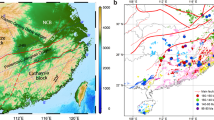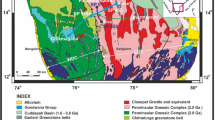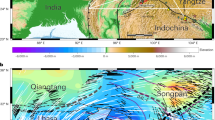Abstract
The Colorado plateau is a large, tectonically intact, physiographic province in the southwestern North American Cordillera that stands at ∼1,800–2,000 m elevation and has long been thought to be in isostatic equilibrium1. The origin of these high elevations is unclear because unlike the surrounding provinces, which have undergone significant Cretaceous–Palaeogene compressional deformation followed by Neogene extensional deformation, the Colorado plateau is largely internally undeformed. Here we combine new seismic tomography2 and receiver function images to resolve a vertical high-seismic-velocity anomaly beneath the west-central plateau that extends more than 200 km in depth. The upper surface of this anomaly is seismically defined by a dipping interface extending from the lower crust to depths of 70–90 km. The base of the continental crust above the anomaly has a similar shape, with an elevated Moho. We interpret these seismic structures as a continuing regional, delamination-style foundering of lower crust and continental lithosphere. This implies that Pliocene (2.6–5.3 Myr ago) uplift of the plateau and the magmatism on its margins are intimately tied to continuing deep lithospheric processes. Petrologic and geochemical observations indicate that late Cretaceous–Palaeogene (∼90–40 Myr ago) low-angle subduction hydrated and probably weakened much of the Proterozoic tectospheric mantle3,4,5 beneath the Colorado plateau. We suggest that mid-Cenozoic (∼35–25 Myr ago) to Recent magmatic infiltration subsequently imparted negative compositional buoyancy to the base and sides of the Colorado plateau upper mantle, triggering downwelling. The patterns of magmatic activity suggest that previous such events have progressively removed the Colorado plateau lithosphere inward from its margins6, and have driven uplift. Using Grand Canyon incision rates7,8 and Pliocene basaltic volcanism patterns, we suggest that this particular event has been active over the past ∼6 Myr.
This is a preview of subscription content, access via your institution
Access options
Subscribe to this journal
Receive 51 print issues and online access
$199.00 per year
only $3.90 per issue
Buy this article
- Purchase on Springer Link
- Instant access to full article PDF
Prices may be subject to local taxes which are calculated during checkout




Similar content being viewed by others
References
Thompson, G. A. & Zoback, M. L. Regional geophysics of the Colorado Plateau. Tectonophysics 61, 149–181 (1979)
Schmandt, B. & Humphreys, E. D. Complex subduction and small-scale convection revealed by body-wave tomography of the western United States upper mantle. Earth Planet. Sci. Lett. 297, 435–445 (2010)
Humphreys, E. et al. How Laramide-age hydration of North American lithosphere by the Farallon slab controlled subsequent activity in the western United States. Int. Geol. Rev. 45, 575–595 (2003)
Lee, C.-T. A., Yin, Q., Rudnick, R. L. & Jacobsen, S. B. Preservation of ancient and fertile lithospheric mantle beneath the southwestern United States. Nature 411, 69–73 (2001)
Li, Z.-X. A., Lee, C.-T., Peslier, A. H., Lenardic, A. & Mackwell, S. J. Water contents in mantle xenoliths from the Colorado Plateau and vicinity: implications for the mantle rheology and hydration-induced thinning of continental lithosphere. J. Geophys. Res. 113 B09210 10.1029/2007JB005540 (2008)
Roy, M., Jordan, T. H. & Pederson, J. Colorado Plateau magmatism and uplift by warming of heterogeneous lithosphere. Nature 459, 978–982 (2009)
Crow, R. S. et al. Shrinking of the Colorado Plateau via lithospheric mantle erosion: evidence from Nd and Sr isotopes and geochronology of Neogene basalts. Geology 39, 27–30 (2011)
Karlstrom, K. E., Crow, R., Crossey, L. J., Coblentz, D. & Van Wijk, J. W. Model for tectonically driven incision of the younger than 6 Ma Grand Canyon. Geology 36, 835–838 (2008)
Smith, D. Insights into the evolution of the uppermost continental mantle from xenolith localities on and near the Colorado Plateau and regional comparisons. J. Geophys. Res. 105, 16769–16781 (2000)
Livaccari, R. F. & Perry, F. V. Isotopic evidence for preservation of Cordilleran lithospheric mantle during the Sevier-Laramie orogeny, western United States. Geology 21, 719–722 (1993)
Humphreys, E. D. Post-Laramide removal of the Farallon slab, western United States. Geology 23, 987–990 (1995)
Huntington, K. W., Wernicke, B. P. & Eiler, J. M. Influence of climate change and uplift on Colorado Plateau paleotemperatures from carbonate clumped isotope thermometry. Tectonics 29 TC3005 10.1029/2009TC002449 (2010)
Spencer, J. Uplift of the Colorado Plateau due to lithosphere attenuation during Laramide low-angle subduction. J. Geophys. Res. 101, 13595–13609 (1996)
Moucha, R. et al. Deep mantle forces and the uplift of the Colorado Plateau. Geophys. Res. Lett. 36 L19310 10.1029/2009GL039778 (2009)
van Wijk, J. W. et al. Small-scale convection at the edge of the Colorado Plateau: implications for topography, magmatism, and evolution of Proterozoic lithosphere. Geology 38, 611–614 (2010)
Benz, H. M. & McCarthy, J. Evidence for an upper mantle low velocity zone beneath the southern Basin and Range – Colorado Plateau transition zone. Geophys. Res. Lett. 21, 509–512 (1994)
Henstock, T. J., Levander, A. & DeepProbe Working Group Probing the Archean and Proterozoic lithosphere of western North America. GSA Today 8, 1–5 16–17 (1998)
Buehler, J. & Shearer, P. Pn tomography of the western United States using USArray. J. Geophys. Res.115 B09315 (2010)
Schmandt, B. & Humphreys, E. Complex subduction and small-scale convection revealed by body-wave tomography of the western United States upper mantle. Earth Planet. Sci. Lett. 297, 435–445 (2010)
Bassin, C., Laske, G. & Masters, G. The current limits of resolution for surface wave tomography in North America. Eos 81, F897 (2000)
Bird, P. Continental delamination and the Colorado Plateau. J. Geophys. Res. 84, 7561–7571 (1979)
Morency, C. & Doin, M.-P. Numerical simulations of the mantle lithosphere delamination. J. Geophys. Res. 109 B03410 10.1029/2003JB002414 (2004)
Conrad, C. P. & Molnar, P. Convective instability of a boundary layer with temperature-and strain-rat-dependent viscosity in terms of 'available buoyancy'. Geophys. J. Int. 139, 51–68 (1999)
Bird, P. Laramide crustal thickening event in the Rocky Mountain foreland and Great Plains. Tectonics 3, 741–758 (1984)
Kay, S. M., Coira, B. & Viramonte, J. Young mafic back arc volcanic rocks as indicators of continental lithospheric delamination beneath the Argentine Puna Plateau, Central Andes. J. Geophys. Res. 99, 24323–24339 (1994)
Ducea, M. N. & Saleeby, J. B. Buoyancy sources for a large, unrooted mountain range, the Sierra Nevada, California; evidence from xenolith thermobarometry. J. Geophys. Res. 101, 8229–8244 (1996)
Bird, P. Formation of the Rocky Mountains, Western United States: a continuum computer model. Science 239, 1507 (1988)
Menzies, M., Xu, Y., Zhang, H. & Fan, W. Integration of geology, geophysics and geochemistry: a key to understanding the North China Craton. Lithos 96, 1–21 (2007)
Foley, S. F. et al. The composition of near-solidus melts of peridotite in the presence of CO2 and H2O between 40 and 60 kbar. Lithos 112, 274–283 (2009)
Ehrenberg, S. N. Petrogenesis of garnet lherzolite and megacrystalline nodules from the Thumb, Navajo volcanic field. J. Petrol. 23, 507–547 (1982)
Lipman, P. W. in The Cordilleran Orogen: Conterminous U. S. (eds Burchfiel, B. C., Lipman, P. W. & Zoback, M. L. ) 481–514 (Geological Society of America, 1992)
Nelson, S. T., Davidson, J. P. & Sullivan, K. R. New age determinations of central Colorado Plateau Laccoliths, Utah — recognizing disturbed K-Ar systematics and re-evaluating tectonomagmatic relationships. Geol. Soc. Am. Bull. 104, 1547–1560 (1992)
Schmandt, B. & Humphreys, E. Seismic heterogeneity and small-scale convection in the southern California upper mantle. Geochem. Geophys. Geosyst. 11 Q05004 10.1029/2010GC003042 (2010)
Liu, K., Levander, A., Niu, F. & Miller, M. S. Imaging crustal and upper mantle structure beneath the Colorado Plateau using finite-frequency Rayleigh wave tomography. Geochem. Geophys. Geosyst. (submitted)
Forsyth, D. W. & Li, A. in Seismic Earth: Array Analysis of Broadband Seismograms Vol. 157 (eds Levander, A. & Nolet, G. ) 81–97 (American Geophysical Union, 2005)
Langston, C. A. Corvallis, Oregon, crustal and upper mantle receiver structure from teleseismic P and S waves. Bull. Seismol. Soc. Am. 67, 713–724 (1977)
Yuan, X., Kind, R., Li, X. & Wang, R. The S receiver functions: synthetics and data example. Geophys. J. Int. 165, 555–564 (2006)
Dueker, K. G. & Sheehan, A. F. Mantle discontinuity structure form midpoint stacks of converted P to S waves across the Yellowstone hotspot track. J. Geophys. Res. 102, 8313–8327 (1997)
Acknowledgements
The USArray data are from the IRIS DMS. A.L., K.L., M.S.M., E.D.H. and B.S. were supported by NSF EarthScope grants EAR-0844741, EAR-0844760 and EAR-0911006. Part of this research was initiated at the CIDER 2008 workshop (A.L., M.S.M.), and part was initiated at the GFZ-Potsdam (A.L.). A.L. acknowledges an Alexander von Humboldt Foundation Research Prize.
Author information
Authors and Affiliations
Contributions
A.L. wrote the receiver function analysis codes and processed the PdS receiver functions. B.S. and E.D.H. wrote the tomography codes and processed the body wave data. M.S.M. and A.L. analysed the SdP receiver functions. K.L. analysed the Rayleigh wave data. K.E.K. and R.S.C. provided uplift and geochemical information. C.-T.A.L. provided geochemical information. All the authors participated in the interpretation.
Corresponding author
Ethics declarations
Competing interests
The authors declare no competing financial interests.
Supplementary information
Supplementary Information
This file contains Supplementary Text and Data, additional references, and Supplementary Figures 1-5 with legends. (PDF 10074 kb)
Rights and permissions
About this article
Cite this article
Levander, A., Schmandt, B., Miller, M. et al. Continuing Colorado plateau uplift by delamination-style convective lithospheric downwelling. Nature 472, 461–465 (2011). https://doi.org/10.1038/nature10001
Received:
Accepted:
Published:
Issue Date:
DOI: https://doi.org/10.1038/nature10001
This article is cited by
-
Post-subduction tectonics induced by extension from a lithospheric drip
Nature Geoscience (2023)
-
Basin record of a Miocene lithosphere drip beneath the Colorado Plateau
Nature Communications (2023)
-
Seismically imaged lithospheric delamination and its controls on the Mesozoic Magmatic Province in South China
Nature Communications (2023)
-
Symptomatic lithospheric drips triggering fast topographic rise and crustal deformation in the Central Andes
Communications Earth & Environment (2022)
-
Long-lived Paleoproterozoic eclogitic lower crust
Nature Communications (2021)
Comments
By submitting a comment you agree to abide by our Terms and Community Guidelines. If you find something abusive or that does not comply with our terms or guidelines please flag it as inappropriate.



